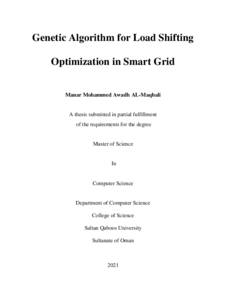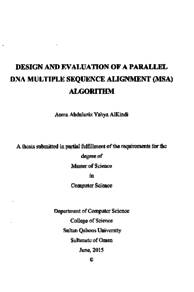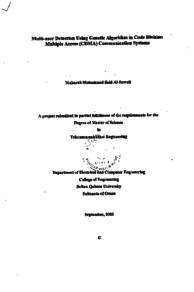وثيقة
Genetic algorithm for load shifting optimization in smart grid.
الناشر
Sultan Qaboos University.
ميلادي
2021
اللغة
الأنجليزية
الملخص الإنجليزي
Nowadays, electricity has become a basic requirement in daily life. Our world is now
seeking to improve the traditional electrical grid (EG) and turn it into a smart grid
(SG), due to the limitations in the current electrical networks. The traditional
electrical grid (EG) is a system to deliver electricity to the consumer for daily use. It
is about interconnected networks, which have power plants, generators, transmission
lines, transformers, substations, distribution lines, and consumption points. Due to
the advances of technology, many electricity companies all over the world are
moving towards the smart grid (SG) the next generation of the electric grid for
providing better reliable and cost-effective services to their customers. The smart
grid (SG) is a combination of the power system, communication, information
technology, and control infrastructures that can monitor, manage and optimize the
operations of all parts of the power system from power generation, power
transportation, and power distribution. Demand Side Management (DSM) is an
energy management function of the smart grid that from the consumer's perspective
is about reducing the electricity consumption during peak hours and enabling a
continuous non-interruptible power supply during the peak demand hours.
This thesis presents a demand-side management strategy based on a load shifting
technique for demand-side management of future smart grids. A service called Load
Shifter for Smart Grid Resources Optimization Middleware (SGROM-LS) is
proposed in this thesis. We provide an analytical model that is formulated as a
mathematical cost minimization problem. The proposed resource optimization
management middleware SGROM- LS aims at reducing the consumer's bill,
reducing power consumption at the peak hours (avoid power disconnection), and
reducing the grid system's energy losses. The Genetic Algorithm (GA) approach is
used to model the problem by collecting day ahead forecast and Service Level
Agreements (SLA) from the consumers. Consumers' forecasts are represented by a
two-dimensional chromosome where a gene consists of allocating a specific
consumer's power task for a specific time slot (24-time slots). The output of the GA
is the best power task plan for the day for all the consumers which minimizes the cost
and reduces the peak demand. The experimental results show that the proposed
strategy achieves substantial savings (38%) in the total cost which will be reflected
in the consumers' bills and reduces the peak load demand of the smart grid to save
the electrical infrastructure for an electricity company.
المجموعة
URL المصدر
الملخص العربي
في الوقت الحاضر، أصبحت الكهرباء شرطا أساسيا في الحياة اليومية. يسعى عالمنا الآن الى تحسين الشبكة الكهربائية الحالية وتحويلها الى شبكة ذكية وذلك بسبب القيود الموجودة في الشبكات الكهربائية الحالية. تعرف الشبكة الكهربائية التقليدية بأنها نظام لتوصيل الكهرباء إلى المستهلك لالستخدام اليومي، وهيه عبارة عن شبكات مترابطة تحتوي على محطات توليد الطاقة والمولدات وخطوط النقل والمحوالت والمحطات الفرعية وخطوط التوزيع ونقاط الأستهالك. نظ ًرا للتقدم التكنولوجي، تتجه العديد من شركات الكهرباء في جميع أنحاء العالم نحو الشبكة الذكية وهي الجيل التالي من الشبكة الكهربائية لتوفير خدمات موثوقة وفعالة من حيث التكلفة لعمالئها. وتحتوي الشبكة الذكية على مزيج من نظام الطاقة والأتصالأت وتكنولوجيا المعلومات، وهي قادرة على مراقبة وإدارة وتحسين عمليات أجزاء نظام الطاقة من توليد ونقل وتوزيع الطاقة. وتستخدم الشبكة الذكية وظيفة اساسية تسمى إدارة الطلب (DSM (وهي إحدى وظائف إدارة الطاقة للشبكة الذكية والتي من منظور المستهلك تتعلق بتقليل ذروة استهالك الكهرباء خالل ساعات الذروة وتمكين إمداد طاقة مستمر من غير انقطاع خالل ساعات ذروة الطلب. تقدم هذه الأطروحة استراتيجية إلدارة الطلب بنا ًء على تقنية تحويل الطاقة للشبكات الذكية المستقبلية. قمنا باقتراح خدمة تسمى تحويل الطاقة للبرمجيات الوسيطة لتحسين موارد الشبكة الذكية (LS-SGROM (في هذه الأطروحة. قدمنا نموذ ًجا تحليليًا تمت صياغته رياضيا كمشكلة لتقليل التكلفة. وتهدف هذه الخدمة إلى تقليل فاتورة المستهلك وتقليل استهالك الطاقة في ساعات الذروة )لتجنب انقطاع التيار الكهربائي( وأيضا تقليل فقد الطاقة في نظام الشبكة. وقد تم استخدام نهج الخوارزمية الجينية (GA (لنموذجة المشكلة من خالل جمع توقعات اليوم السابق واتفاقيات مستوى الخدمة (SLA (من المستهلكين. فقد أظهرت النتائج التجريبية أن استراتيجية إدارة الطلب المقترحة تحقق تخفيض التكلفة بنسه كبيرة تصل الى )83 )٪من التكلفة الأجمالية، سينعكس على فواتير المستهلكين وأيًضا تقليل طلب الحمل الأقصى للشبكة الذكية للحفاظ على البنية التحتية الكهربائية لشركة الكهرباء.
قالب العنصر
الرسائل والأطروحات الجامعية



